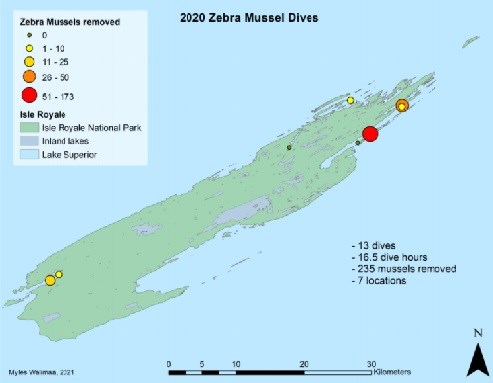
Miles Walimaa
Isle Royale National Park (ISRO) needs your help to prevent the spread of invasive zebra and quagga mussels in Lake Superior. These bivalves, native to fresh waters in Eurasia, were initially transported to the Great Lakes via ships’ ballast water, and have spread to waters across the United States via boats and other recreational equipment. These tiny invaders threaten the integrity of aquatic ecosystems. They can quickly reproduce and cover lakebeds, suffocating native mussels and changing food webs on which other aquatic species depend. Additionally, according to the Center for Invasive Species Research at the University of California, Riverside, it is estimated that the cost of management and economic damage of zebra mussels in the Great Lakes alone exceeds $500 million per year.
Lake Superior was long thought to be inhospitable for these invasive mussel species due to its cold temperatures and low concentrations of the calcium that mussels need for shell growth. However, recent scientific findings from Isle Royale show that these invasive mollusks are hardier than previously thought. In 2018, an infestation of over 3,000 zebra mussels was discovered living on a dock at Mott Island, a part of the Isle Royale archipelago. It was manually removed by divers. Zebra mussels prefer to live on hard surfaces. Scientists at Isle Royale have been deploying artificial surfaces beneath the water and subsequently inspecting them for the presence of invasive mussels. This helps them detect the presence of these aquatic invaders in specific locations. In addition to the infestation on the Mott Island dock, zebra mussels have also been found at other locations in the park, such as Washington Harbor, Malone Bay, and Belle Isle.
How are the mussels getting to Isle Royale waters? One theory is that mussels are hitching a ride to ISRO by clinging to private and commercial boats, which come from more suitable invasive mussel habitats. Since these invaders currently remain in low numbers at Isle Royale, now is the best time for action to slow or even stop the invasion.
The zebra and quagga mussel invasion in Lake Superior is still very limited, with established infestations only found in high-traffic harbors. Early action to detect and remove these tiny invaders from ISRO and other Lake Superior habitats can prevent them from achieving the numbers they have in other Great Lakes. A National Park Service project beginning in 2021 aims to prevent invasive mussel establishment and related ecosystem damage to four Upper Midwest parks, including Isle Royale National Park, through targeted prevention, early detection, and rapid response efforts. Each park (Apostle Islands National Lakeshore, Grand Portage National Monument, ISRO, Pictured Rocks National Lakeshore, and Voyageurs National Park) features high resource quality and imminent invasive mussel threats. At each park, boat cleaning stations are being deployed and prevention-based outreach efforts are being implemented or enhanced. NPS divers, cooperators, and volunteers will survey high-risk locations for invasive mussels. Any new infestations will be removed manually.
There are many actions that individuals can take to slow the spread of these aquatic hitchhikers. Live zebra and quagga mussels are still transported through recreational boating. As these mussels can survive for up to five days out of water attached to boats and other equipment, boat owners should make sure to inspect their boat, trailer, and any other recreational equipment, remove all mud, plants, or animals; drain all bilge water; wash all parts of their boats, paddles, and other equipment, and let their equipment dry for at least five days before entering another fresh water body. Don’t forget to stay informed and inform others on the threats invasive species pose to the Great Lakes. Together, we can make a difference in preserving the biodiversity and natural beauty of our national parks.
Last updated: September 27, 2021
